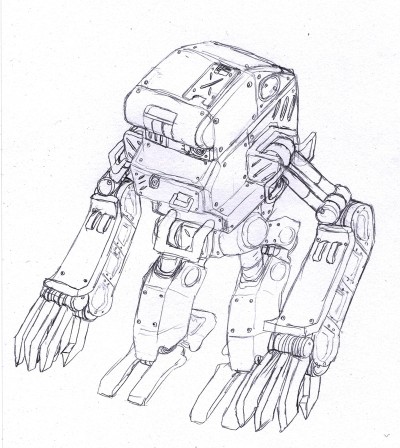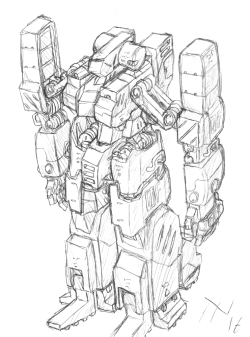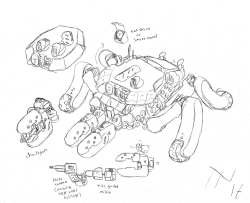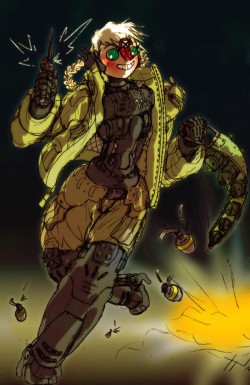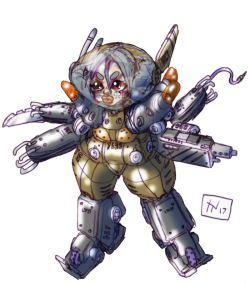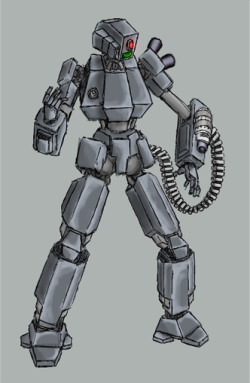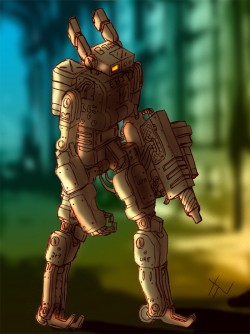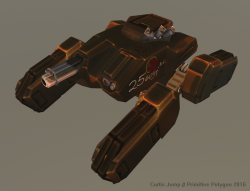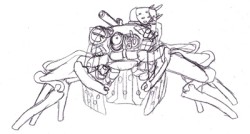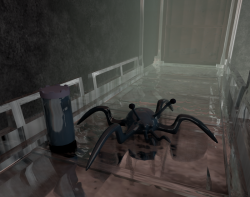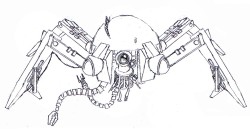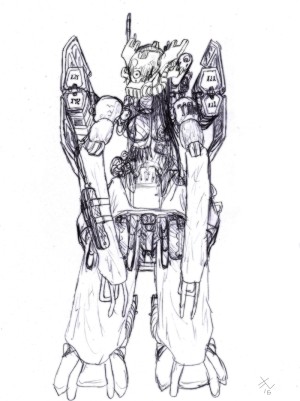Table of Contents
Automata
Automata (singular, Automaton) are the machines designed by the Freespacers, which allows them to operate entire fleets of ships with little or no organic crew. This is something quite important to a race with such a relatively tiny organic population (just over 1 million, as compared to the billions most other races have). Furthermore, 'living' crews incur a much higher maintenance cost (water, oxygen, food, recreation, productivity lost sleeping, etc) than machines, which further adds to the desirability of predominantly automaton crews aboard Freespacer vessels.
Simple-minded drones slaved to a larger computer network were common in the past, but as their reliance on motherships decreases, Automata are increasingly being constructed as fully independent and self-aware beings. Bodies made of purely metallic materials or salvaged composite forms continue to be the norm, yet organic (and even humanoid organic) components are also sometimes used, creating beings easily confused with human cyborgs.
Animalistic-type robots that simply follow one order or directive continuously are also exceedingly common. Eternally vigilant robot guard dogs or vent-dwelling repair squid are just two examples.
Intelligence Levels
SI Automata
Self-aware, learning intelligences in a robotic platform. Capable of the entire range of human emotion and experience, although have a limited lifespan as the program tends to “bloat” the more it learns (e.g., the longer it runs). Eventually the program must be moved into a dedicated computer core or it will drastically slow down due to a lack of memory and processing speed in its platform – until it reaches what is effectively a coma. They are considered Freespacer citizens in all respects, and are always equipped with mindware with which to access the polysentience.
MR Automata
Independent machines every bit as smart as a human being, yet constructed with a particular task in mind. “Mid Range” Automata like this are often left to act alone, repairing technology or even building new spacecraft just out of pure inherited artistic passion and dedication. Rather than being directly ordered around, this means that Freespacers can rely on an artificial ecosystem of workers, all toiling towards some rudimentary similar goal of survival; Sometimes humanoid versions of these machines are even sent into the territories of other races in order to retrieve new technologies, and can be quite capable in these tasks, aside from their highly eccentric and single minded personalities rubbing foreigners the wrong way.
NU Automata
NU stands for “nonvolitional”; meaning to have no free will. While externally identical to SI Automata, they are effectively just empty shells with a rudimentary AI. They are intelligent enough to follow orders, but often lack the ability to make judgement or change orders on their own. Some designs can be particularly small and useful only for straight-forward tasks or remote control, whilst others are so large and overly engineered, that they can actually become SI if left unattended for long enough.
There is never any limit to a Freespacer machine's personal growth, other than just the basic availability of resources and hardware.
Construction
Traditional Custom Models
Nuclear powered and water cooled, and commonly constructed from base metals like steel or tungsten if not outright scrap metal. Automata are the physical embodiment of 'making do' and will generally only integrate more complex alien components (like aether technology or humanoid android parts) if it's something that has been stolen or salvaged from another race. Anti-gravity propulsion technology is about as common as thrusters at this point, both with their pros and cons. This means they tend to look very crude indeed, despite a certain inner sophistication. One major boon is that they can be repaired almost anywhere at any time, regardless, which is pretty much paramount to the concept of living free in space.
Function over form, they can look either humanoid in inhumanoid, depending on what best suits their intended purpose.
Organic Components
It's not the norm, but using cloned humanoid genetic material is sometimes helpful in making a creature which has both the positive qualities of a machine and a organic being. For instance, they can be grown relatively quickly and self heal after production, they can just eat food and don't require as many specialist replacement parts, e.t.c… These 'organic Automata' are somewhat of an unintentional Freespacer secret, mostly mistaken by foreigners as simple humanoid cyborgs. For the Freespacers themselves, through, there is no difference or moral question over using what looks like bits of human beings as spare parts. If machines can be considered fully valid sentient beings, after all, then meat can be considered just another recycled component!
Mass Production Models
It's rare, but sometimes the Spacers will build identical bodies if they need an instant army, or are dealing with a population crisis.
See; Militant, Partisan and Deathcrawler Auto-Tank.
Junkers
Self-replicating robots generally used for repair, but also occasionally seeded into ships as a security measure. They are almost always spider-like, but because of their simplistic tasks, are sometimes made from genetically engineered material rather than metal.
See; Junkers and Liquid Ally.
Somewhere Inbetween
Inevitably, there are also organics with so many cyborg parts, or automata with so many synthetic organic parts, that what they started as is purely a trivial fact. The former tends to be individuals who have lost their original bodies in combat, accidents, or intentionally transcending into an electronic brain.
The later consists of mostly sensory-obsessed neurotic androids, but the odd non-sentient humanoid worker prototype is also an increasingly common sight, given the Wire Guided's obsession with self-sufficient pseudo-organic systems…
